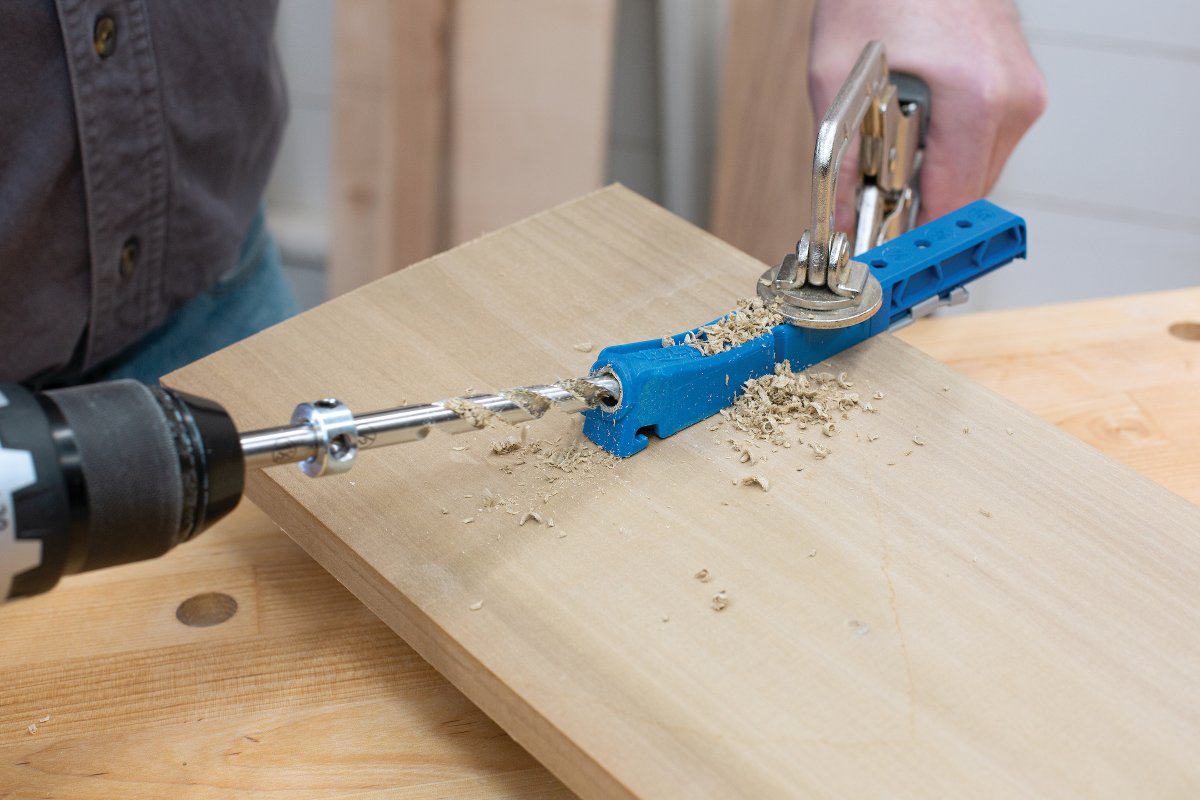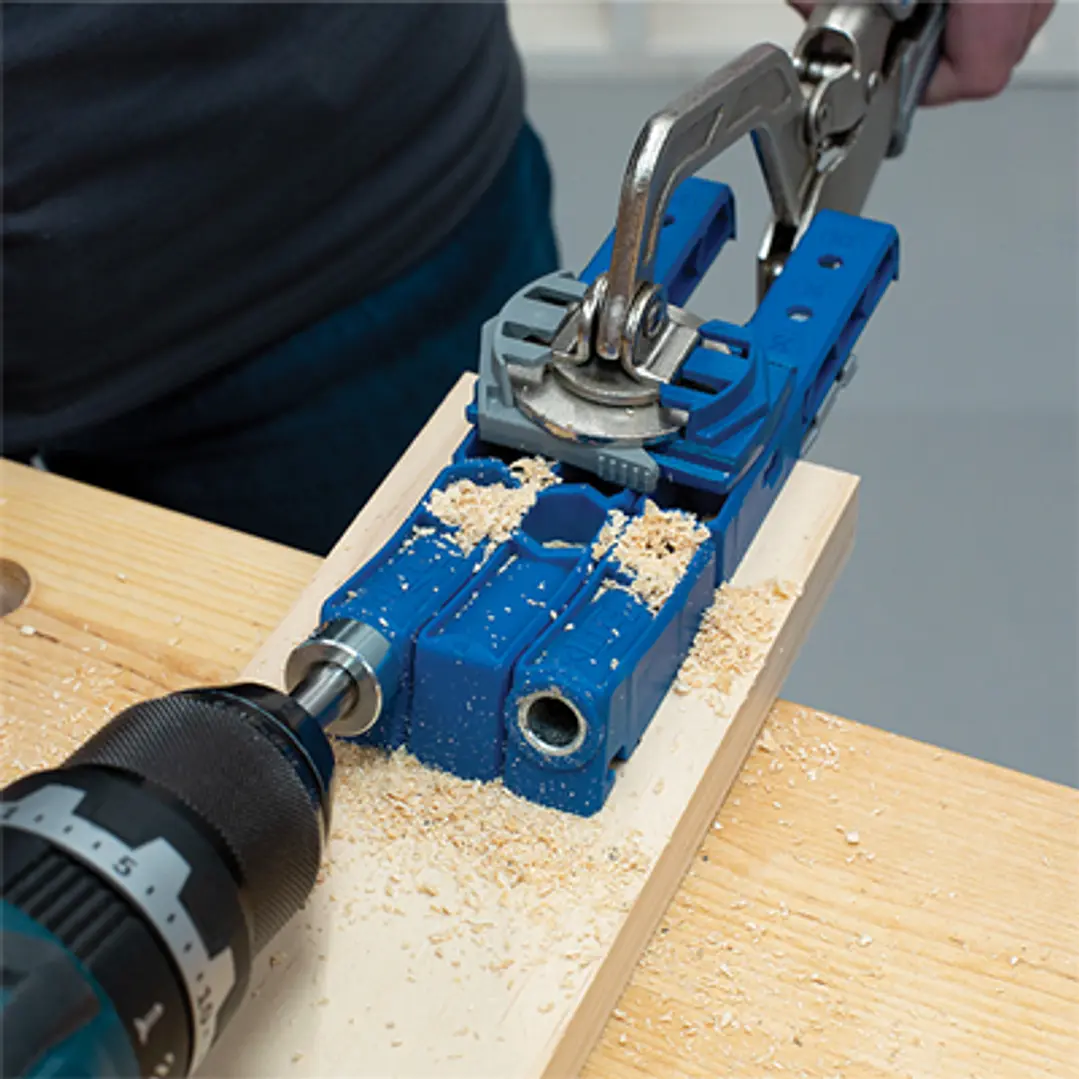Craig Sommerfeld’s invention of the first Kreg jig in the late 1980s changed woodworking forever. These innovative tools create strong, reliable joints in minutes, unlike traditional joinery methods that take hours to complete.
Pocket-hole joints prove remarkably strong and versatile for furniture building, cabinet construction and woodworking projects. Their reversible design lets you take pieces apart without damaging the wood. This makes them perfect for both beginners and experienced woodworkers who want to streamline their work.
This guide shows you the quickest way to use a pocket hole jig, from picking the right equipment to getting perfect joints every time. You’ll learn everything you need to improve your woodworking skills and project quality, whether you start with a basic Kreg Jig K4 or invest in professional-grade tools.

Time-saving advantages over traditional joinery methods
The biggest advantage for businesses is the time saved with pocket hole joinery. Traditional joinery methods might need hours of precise cutting and fitting, but pocket hole joints come together in minutes.
The joint becomes secure as soon as you drive the screws—no waiting for glue to dry before moving forward. Projects that took days now take hours, which optimizes production efficiency and cash flow.
Pocket hole screws’ self-clamping nature makes assembly smoother. Though you’ll use clamps during initial assembly, you can remove them right after driving the screws. Your shop needs fewer clamps, and production moves along without bottlenecks.
Business owners worried about quality perception should know that pocket holes can go on unseen surfaces or take matching plugs. You’ll create clean, professional-looking products while keeping the efficiency advantages of pocket hole joinery.
Pocket hole joinery gives woodworking businesses an ideal mix of speed, strength, and simplicity. It helps maximize productivity without sacrificing quality or requiring complex equipment.
Choosing the Best Pocket Hole Jig for Your Business
Your woodworking business’s productivity and quality depend a lot on choosing the right pocket hole jig. The right equipment becomes more important as your projects grow and production needs rise.
Entry-level options: Kreg Jig K4 vs. Harbor Freight alternatives
New businesses or those that only need pocket hole joinery sometimes can find economical solutions without spending too much money upfront. The Kreg K4 costs about $99 and remains a reliable choice. This older model still delivers dependable results with its manual board thickness adjustments and built-in clamp system.
Harbor Freight makes similar jigs that offer great value at around $65 when you use their common 20% off coupons. These all-aluminum jigs let you adjust hole width spacing – something you won’t find in similar Kreg models. But some users say Harbor Freight jigs cause more tear-out even with Kreg bits. This could slow down your finishing time and affect quality.
The choice comes down to how often you’ll use it and whether joints will show. Harbor Freight jigs might work well enough if pocket holes stay hidden, saving you money. But if you need clean, consistent pocket holes, the Kreg K4’s reliable performance might be worth the extra cost.
Mid-range solutions: Kreg Pocket Hole Jig 320 and competitors
Many small to medium shops find the Kreg Pocket Hole Jig 320 hits the sweet spot at about $40. This adaptable jig has dual drill guides, a removable spacer, and thickness stops that work with materials from 1/2″ to 1-1/2″ thick. You can adjust pocket-hole spacing thanks to its modular design, making it work well for different projects.
Other brands like Massca make similar jigs. The Massca M1’s magnetic system sticks to steel clamp pads, making positioning easier. Some models feature all-metal construction instead of Kreg’s polymer body.
The Kreg 320 stands out for several good reasons:
- Its compact size works great in tight spaces and moves easily between jobs
- Everything stays together in the included carrying case
- The GripMaxx™ anti-slip base keeps holes consistent without slipping
- You get lifetime warranty on hardened steel drill guides
Production-level systems: Comparing top-tier options
Bigger production volumes might justify spending more on advanced systems. Kreg’s most sophisticated jig, the 720PRO, costs about $130. It features Automaxx® clamping that adjusts by itself to materials from 1/2″ to 1-1/2″ thick. This bench-mounted system has extension wings to support bigger workpieces.
The Kreg Foreman makes sense for serious production needs. This machine-based system cuts pocket hole drilling time in half while requiring less effort. It costs more but helps shops that drill lots of pocket holes daily by speeding up work and reducing worker fatigue.
The Massca M2 Pro Aluminum system offers another production-focused choice. It features cast-aluminum construction, built-in dust collection, and vertical drilling that speeds up operation.
ROI considerations for different business scales
Small shops with changing production needs should look for versatility. The Kreg 520 works great both as a portable hand-held jig and mounted on a bench.
Medium-sized shops with steady work might get the best value from the 720 series. The extra $30-40 over basic models pays off quickly through faster assembly times.
High-volume manufacturers should take a closer look at machine systems like the Foreman versus semi-automated options. These systems can double your production speed and reduce repetitive motion issues while keeping quality consistent. Shops making multiple projects daily will see this cost pay off quickly.
Your choice should match both current work and future growth plans. Shops working mostly with 3/4″ stock might do fine with simpler jigs. But if you use different materials often, you’ll want systems that offer more adjustment options.

Setting Up Your Kreg Pocket Hole Jig
The right setup of your pocket hole jig will give a solid base for successful joinery. Your project’s quality and production speed depend on it. This step takes you from just owning the tool to getting professional results.
Workpiece preparation and measurement
Getting the material thickness right is the life-blood of pocket hole joinery. Kreg 300-, 500-, and 700-Series jigs come with a Material Thickness Gage that makes this job easy. You can quickly see if your board fits the ½”, ¾”, or 1½” categories by holding the gage against its edge. These are the most common thicknesses you’ll find in woodworking projects. The gages also show ranges between standard sizes to help you set up correctly.
Your pocket holes should be marked at least 2″ away from the edges of your workpiece. This prevents the wood from splitting. Try to place these marks where they won’t show in your finished piece.
Adjusting for material thickness
The jig and drill bit setup depends on your material thickness. The Kreg 310 or 320 needs a simple slide adjustment until you see your measurement in the small window. With the 520PRO2, squeeze the tabs on each side of the drill guide block and slide it where you need it. The 720 series makes things easier with Automaxx® technology that adjusts itself to your material.
The Easy-Set Pocket-Hole Drill Bit needs the stop collar moved until your material thickness shows in the window. Then tighten the setscrew. This step makes sure your pocket holes have the right depth and line up correctly.
Proper clamping techniques for maximum efficiency
Good clamping is a great way to get better joints and work faster, though many woodworkers overlook it. The biggest problem with pocket hole joinery comes from boards that move during assembly.
Face clamps help control the outward force that happens when you drive pocket hole screws. This force can split your workpiece if left unchecked. If you’re in a production shop, think about setting up permanent clamping stations to work faster.
Bar clamps work great too, especially when you have larger projects. Put them at 45-degree angles on both sides of the joint. Switch between top and bottom positions to spread the pressure evenly. This careful approach keeps everything lined up perfectly while you work.
Step-by-Step Guide to Using a Pocket Hole Jig
Quality equipment alone won’t guarantee flawless pocket hole joints. You need to become skilled at the process to achieve professional results. This piece shows you the techniques that will help you get the most from your pocket hole jig investment.
Marking and positioning your workpiece
Strong pocket hole joints need precise positioning as their foundation. Narrow boards (1½” wide like 1x2s) should be centered on the drill guide’s two right holes for drilling. Boards that are 2½” wide (like 1x3s) work best when centered on the two left holes.
Wider boards and plywood panels need pocket holes spaced about 6″ apart, staying at least 2″ away from edges. This spacing gives you optimal strength without weakening the material. A quick visual check ensures your board fully covers the guide holes and prevents accidental side drilling.
Drilling perfect pocket holes every time
You can drill perfect holes by following these five simple steps:
- Measure your board’s exact thickness (commonly ½”, ¾”, or 1½”)
- Set the jig height according to measured thickness
- Set the drill bit depth collar correctly
- Position and clamp your workpiece securely
- Drill each pocket hole until the stop collar touches the jig
The drill setting works best for pocket holes – avoid using impact mode. Clear shavings by pulling the bit out once or twice while drilling. This keeps your bit cool and makes the process easier.
Selecting the right screws for different materials
Material type and thickness determine which screws you should use. Softwoods (pine, spruce, fir) and plywood need coarse-thread screws. Fine-thread screws work better for hardwoods (oak, maple, walnut) to prevent splitting.
Your material thickness determines screw length:
- ½” material: 1″ screws
- ¾” material: 1¼” screws
- 1½” material: 2½” screws
Outdoor projects need Blue-Kote screws with triple anti-corrosion protection or stainless steel options. Standard zinc-coated screws work fine for indoor projects.
Assembly techniques for strong, reliable joints
Clamping pieces during assembly creates tight joints. Face clamps work great for edge joints, while right-angle clamps suit 90-degree connections better.
A drill/driver set to medium torque (9-11 setting) drives screws effectively. Drive steadily until the joint pulls tight. Stop before you overdrive – this prevents stripped holes and split wood.
A thin layer of wood glue on joint surfaces adds extra strength. While not crucial for stability, it helps prevent gaps from seasonal wood movement.
Maximizing Productivity with Pocket Hole Jigs
Woodworking businesses that want to scale their operations need to turn pocket hole joinery from an occasional technique into the life-blood of production. This requires smart setup and efficient workflows.
Creating jig stations for production workflows
Custom workstations make pocket hole joinery much more efficient. Professional woodworkers build dedicated pocket hole jig centers with folding “wings.” These provide a wide, stable base and can be stored compactly when not used. The stations usually have built-in storage drawers with hardboard dividers that keep screws, bits, and drivers organized.
The best jig stations should include these productivity features:
- Sliding inserts on each wing to support large workpieces
- Adjustable stops that help drill similar hole placements across multiple pieces
- Integrated dust collection that keeps the workspace clean
- Permanent mounting to ensure consistent results
Mobile operations and contractors need portable versions of these workstations to stay efficient while working on-site. These compact designs let workers quickly set up and break down without tools at job sites.
Batch processing strategies for efficiency
Stop blocks are simple yet powerful tools that streamline pocket hole production. You can drill holes at similar spots across multiple workpieces without measuring each time by placing stop blocks on your jig station. This works great when making cabinet face frames, drawer components, or furniture parts that need consistent hole placement.
Good preparation prevents production bottlenecks. Mark all project parts in their assembly orientation before drilling to line up everything correctly. The parts should be cut and laid out in their final configuration with marked back faces. This simple step helps avoid assembly errors and extra work.
Integrating pocket hole joinery into your business model
Pocket hole joinery gives businesses impressive returns through time savings. Traditional joinery needs hours of glue-up time, but pocket hole connections are secure right away. This lets projects move forward without delays. Simple pocket hole jigs speed up production substantially. Machine-based systems like the Kreg Foreman can drill pocket holes twice as fast with half the effort[292].
Cabinet shops can eliminate production bottlenecks in face frame construction with pocket hole joinery. More importantly, workers need minimal training – anyone who can use a drill and clamp a workpiece can create professional-quality joints.
The business case ended up focusing on balancing equipment costs against labor savings and improved throughput. Small operations see great returns even with entry-level jigs, while high-volume shops quickly recover their investment in production equipment.
Pocket hole joinery revolutionizes woodworking businesses regardless of their size. This straightforward method delivers professional results and cuts production time by a lot. Clever business owners know pocket hole systems quickly pay for themselves through faster projects and lower labor costs.
Your success with pocket hole joinery relies on three things: the right equipment, correct setup, and smooth workflows. Small shops do well with versatile jigs like the Kreg 320. High-volume manufacturers get great returns from production-focused systems like the Foreman.
Woodworking operations see the best results when they set up dedicated pocket hole stations and use batch processing. These efficient workflows, paired with good technique and materials, help businesses complete projects faster without quality loss.
Pocket hole joinery’s business value shows in its immediate effect on productivity. Projects that used to take days with traditional joinery now wrap up in hours. Business owners can take on more work and expand their operations. This practical joining method helps them keep prices competitive while delivering the professional results customers want.
Here are some FAQs about pocket hole jig:
Do you really need a pocket hole jig?
While not absolutely necessary, a pocket hole jig like the Kreg pocket hole jig makes creating strong, hidden joints much easier and more precise. For consistent, professional results in woodworking projects, using the best pocket hole jig available will save time and ensure proper alignment. The Massca pocket hole jig and other quality jigs help beginners and pros alike achieve clean pocket holes without guesswork.
What can I use if I don’t have a pocket hole jig?
If you don’t have a pocket hole jig, you can try freehand drilling at an angle, though this is less accurate. Another option is using dowels or mortise-and-tenon joints as alternatives to pocket hole joinery. However, for the strongest and easiest solution, investing in a Kreg pocket hole jig or similar system is recommended for reliable results.
What are the disadvantages of a pocket hole joint?
Pocket hole joints, even when made with the best pocket hole jig, can be visible on one side of the workpiece, which may not be ideal for fine furniture. They also require specific screws and may not be as strong as traditional joinery methods for heavy-duty applications. However, when using a quality tool like the Massca pocket hole jig, these joints are still incredibly useful for many projects.
What size Kreg jig for 2×4?
For joining 2×4 lumber, the Kreg pocket hole jig R3 or K4 model works well, as they accommodate thicker stock. These jigs allow you to adjust for material thickness, ensuring proper screw placement in dimensional lumber. Learning how to use Kreg pocket hole jig systems correctly will help you achieve strong joints in 2×4 construction projects.
What not to do with pocket holes?
Avoid using pocket holes, even with the best pocket hole jig, for joints that will bear excessive weight or stress, as they have limitations. Don’t place pocket holes too close to the edge of the wood, as this can cause splitting. Also, never skip clamping when using a Kreg pocket hole jig, as proper pressure ensures tight, secure joints.
Can I make my own pocket hole jig?
While possible to make a DIY pocket hole jig by drilling angled holes in a block of wood, it won’t be as precise as a commercial jig like the Massca pocket hole jig. Homemade jigs lack the adjustability and durability of manufactured versions such as the Kreg pocket hole jig. For frequent use, investing in the best pocket hole jig available will yield better long-term results.
What is an alternative to a pocket hole?
Alternatives to pocket holes include dowel joints, biscuit joinery, or traditional mortise-and-tenon techniques. While these methods can be strong, they often require more skill and time than using a Kreg pocket hole jig. For quick and sturdy joints in most woodworking projects, a pocket hole jig remains one of the most efficient solutions.
Do you need a clamp for a pocket hole jig?
Yes, a clamp is essential when using any pocket hole jig, including the Kreg pocket hole jig, to hold workpieces firmly together during drilling. Without proper clamping, the wood can shift, resulting in misaligned or weak joints. Many of the best pocket hole jigs come with built-in clamps or recommend using separate ones for stability.
How to drill a 90 degree hole without a jig?
To drill a 90-degree hole without a jig, you can use a drill press or carefully guide a handheld drill while checking with a square. However, for angled pocket holes, a tool like the Massca pocket hole jig or Kreg pocket hole jig ensures consistent accuracy. Learning how to use Kreg pocket hole jig systems properly will give you better results than freehand drilling.
FOLLOW US ON FACEBOOK
RECENT POSTS
TAGS
About The Memory Hole
You've reached TheMemoryHole.org! A diverse lifestyle blog with content on a variety of different topics to help you define and live the life you want to live! Thanks for stopping by!
Copyright © The Memory Hole. All rights reserved.







